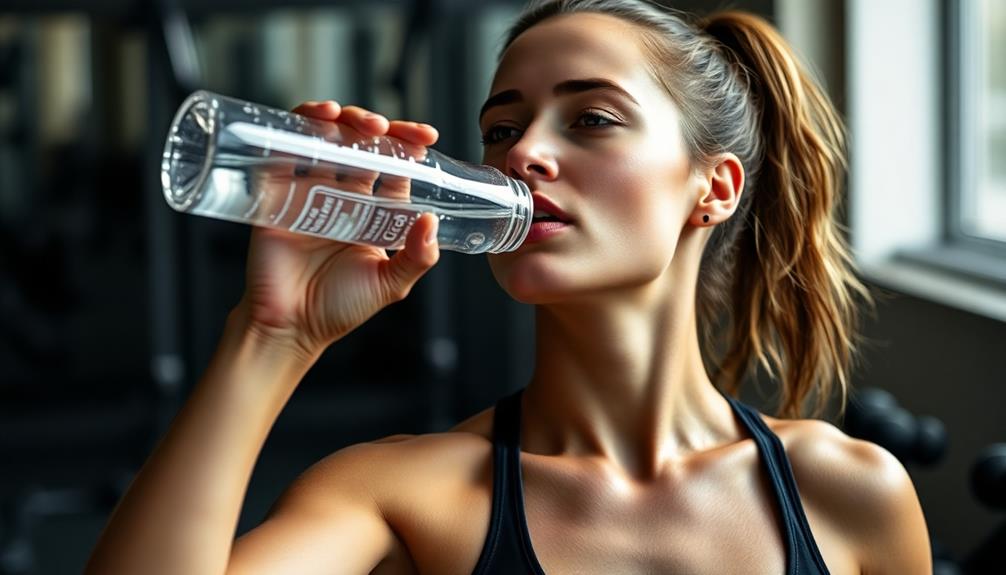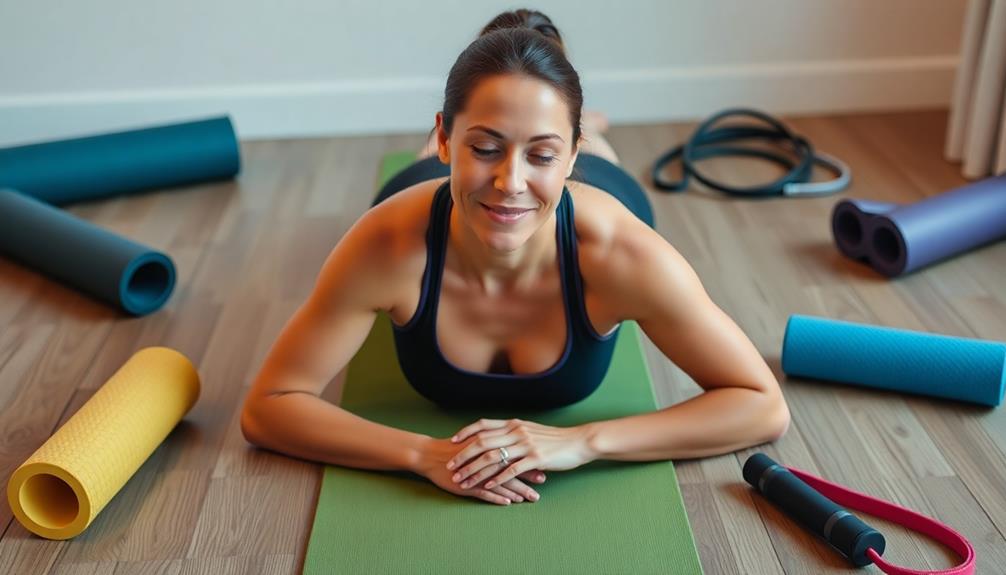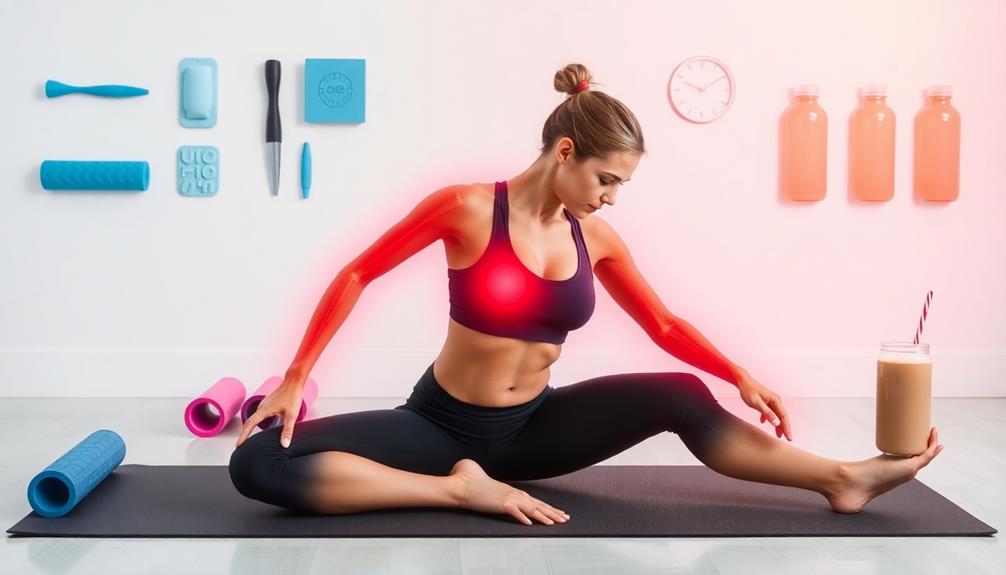To reduce Delayed Onset Muscle Soreness (DOMS) quickly, try these three effective tips. First, stay hydrated by drinking 8-10 glasses of water daily and replenishing fluids lost during exercise. Second, engage in gentle movement and stretching, focusing on sore muscle groups with light activities like walking or swimming. Third, prioritize proper nutrition and supplements, consuming protein to repair muscle fibers and carbohydrates to refill energy stores. Additionally, consider incorporating antioxidants, omega-3s, and tart cherry juice into your diet. These strategies can help alleviate muscle soreness and speed up recovery. For more in-depth information on each tip, continue exploring these methods to optimize your post-workout recovery.
Core Insight
- Stay hydrated by drinking plenty of water and consider electrolyte gummies to aid recovery.
- Engage in gentle movement and stretching to promote blood flow and reduce muscle soreness.
- Consume protein-rich foods and antioxidants to repair muscle fibers and combat inflammation.
- Get adequate rest and quality sleep to allow your muscles time to repair and rebuild.
- Use compression sleeves or cold therapy to boost blood flow and reduce inflammation in sore muscles.
Stay Hydrated

Drinking water is crucial for reducing muscle soreness after an intense workout. Water helps your muscles recover by removing toxins and reducing swelling. Aim to drink 8-10 glasses of water every day. If you sweat a lot during exercise, drink an extra 16-20 ounces of water for each pound of sweat lost. Adding electrolyte gummies to your post-workout routine can help you hydrate better and recover faster by replacing important minerals.
Don't just drink water when you're thirsty. Sip water regularly throughout the day and during your workout. Drinks with electrolytes can also be helpful, especially after tough workouts or when it's hot outside. These drinks replace minerals lost through sweat and help keep your body's fluids balanced.
Gentle Movement and Stretching

Gentle movement and stretching are great for reducing muscle soreness after a tough workout. Even though it might seem strange, light exercise can help sore muscles feel better. Start with easy activities like walking or swimming. This gets more blood flowing to your sore muscles, which helps clear out waste and brings in nutrients to help you recover. Wearing compression sleeves during these activities can boost blood flow even more and speed up recovery, especially for specific body parts like calves or knees.
After that, add in some gentle stretching. Focus on the sore muscle groups and hold each stretch for 15-30 seconds without bouncing. Don't overdo it – you should feel a mild stretch, not pain. Dynamic stretches that involve moving through a range of motion can work really well. Don't forget to breathe deeply and relax while you stretch. The key is to do these gentle movements and stretches consistently throughout the day for the best relief from muscle soreness.
Proper Nutrition and Supplements

Eating right is key to reducing muscle soreness and helping your muscles recover. Make sure you're getting enough protein to fix damaged muscle fibers and carbs to refill your energy stores. Eat plenty of foods with antioxidants to fight inflammation. HMB supplements may also help reduce soreness and speed up recovery. They come in different forms, so you can choose what works best for you.
Some other supplements that might help with muscle soreness are:
- Omega-3s: They can lower inflammation and soreness.
- Tart cherry juice: It's known to be anti-inflammatory.
- BCAAs: They may help your muscles recover faster.
Drink lots of water during the day to stay hydrated. This helps bring nutrients to your muscles and remove waste. Eating foods high in potassium, like bananas, can also stop muscle cramps. While supplements can help, they shouldn't replace a healthy diet. Always talk to your doctor before starting any new supplements.
Frequently Asked Questions
How Long Does DOMS Typically Last?
You'll typically experience DOMS for 24 to 72 hours after intense exercise. It usually peaks within the first two days and gradually subsides. However, the duration can vary depending on your fitness level and workout intensity.
Can Massage Help Alleviate DOMS Symptoms?
Yes, massage can help alleviate DOMS symptoms. You'll find it reduces muscle tension and improves blood flow. It's most effective when done 24-48 hours after exercise. Try gentle self-massage or book a professional session for relief.
Is It Safe to Exercise While Experiencing DOMS?
You can exercise with DOMS, but listen attentively to your body. Light activities can help increase blood flow and reduce stiffness. However, refrain from intense workouts targeting the same muscle groups until you've recovered.
Do Compression Garments Reduce DOMS Intensity?
Yes, compression garments can help reduce DOMS intensity. They'll improve blood flow and reduce muscle oscillation during exercise. You'll likely experience less muscle soreness and swelling when you wear them during and after your workouts.
Can Alternating Hot and Cold Therapy Provide Relief From DOMS?
Yes, alternating hot and cold therapy can help relieve DOMS. You'll find it reduces pain and inflammation. Start with heat to increase blood flow, then switch to cold to decrease swelling. Repeat this process for best results.

